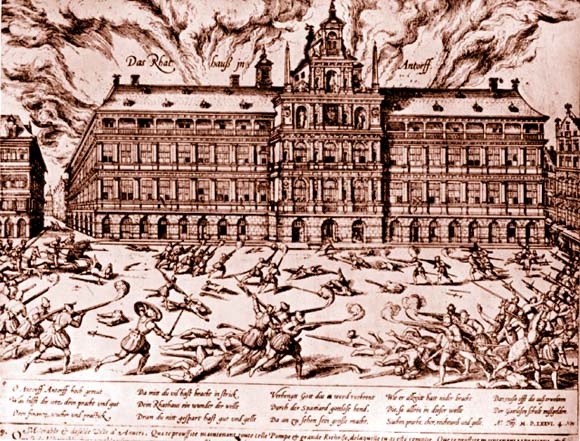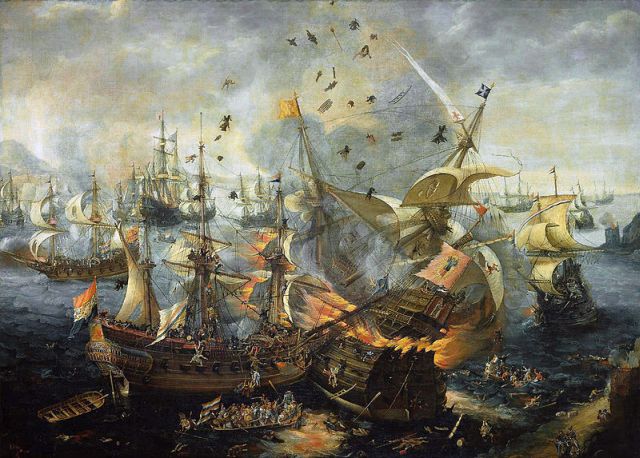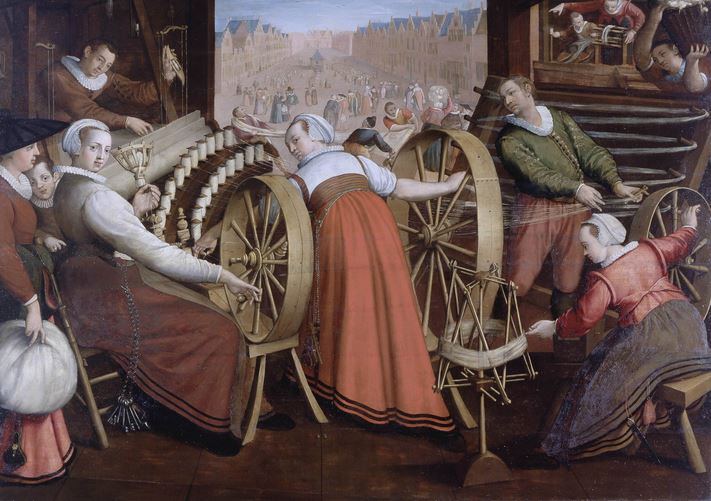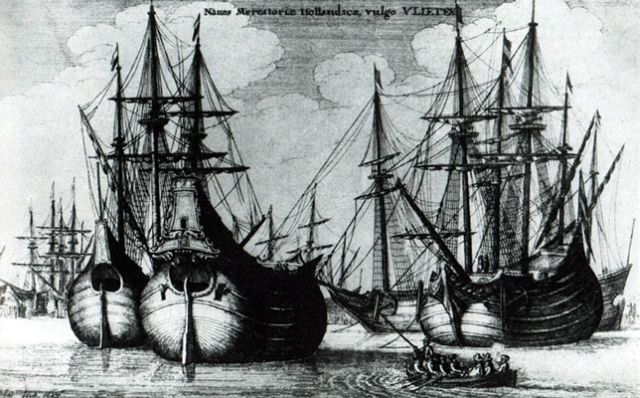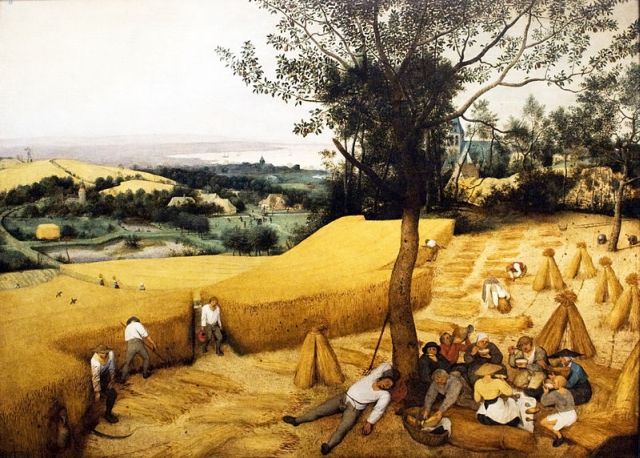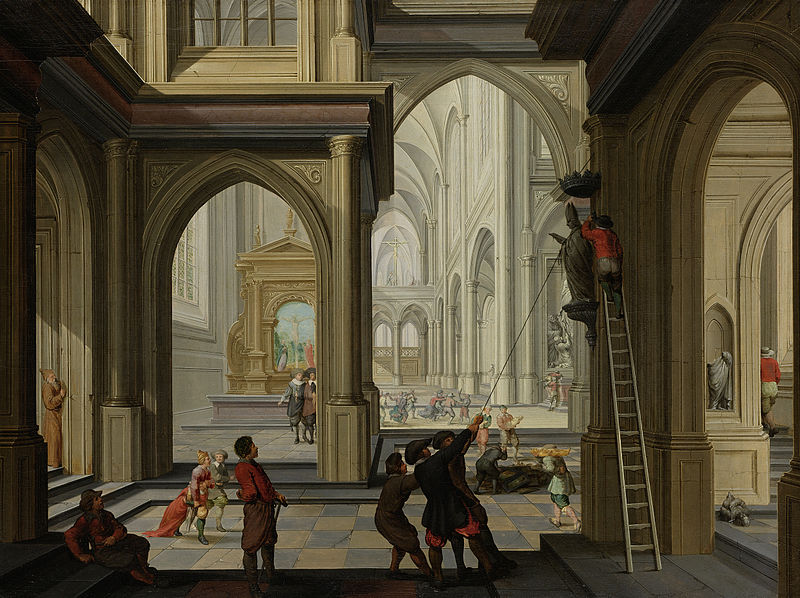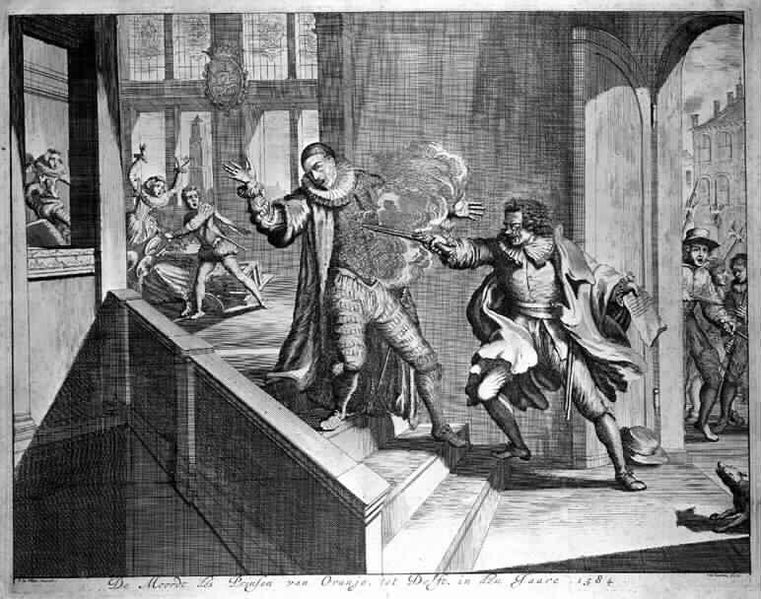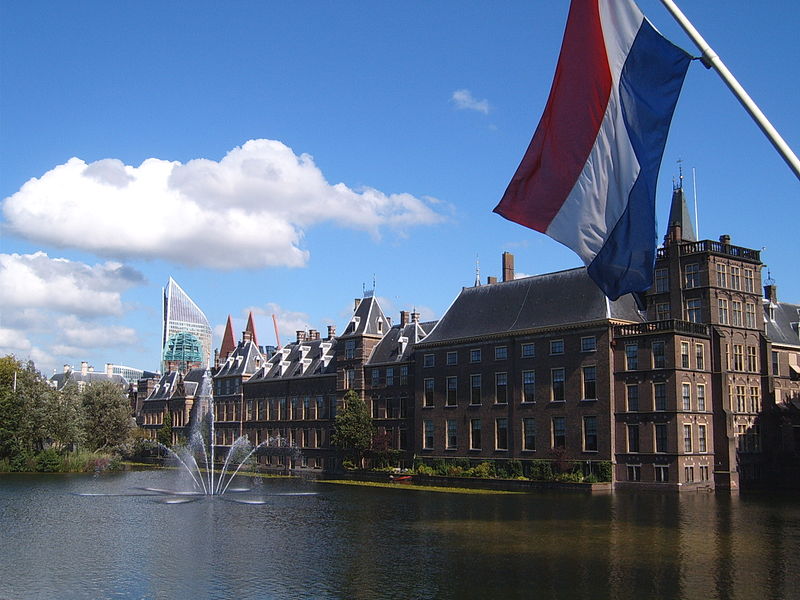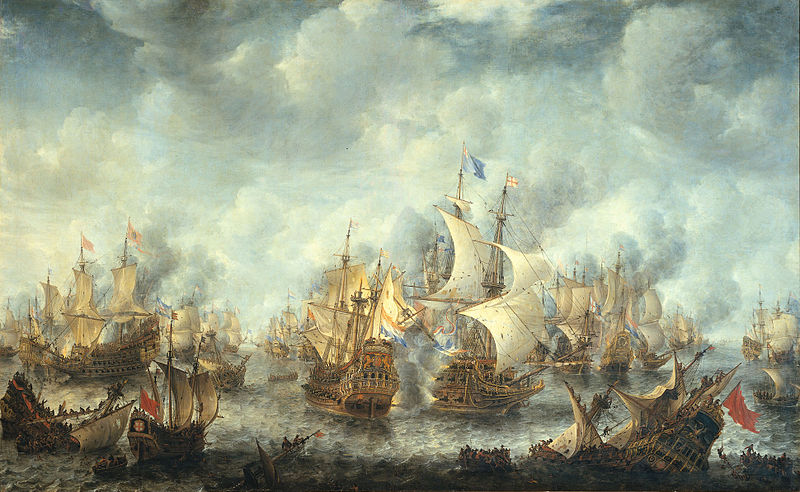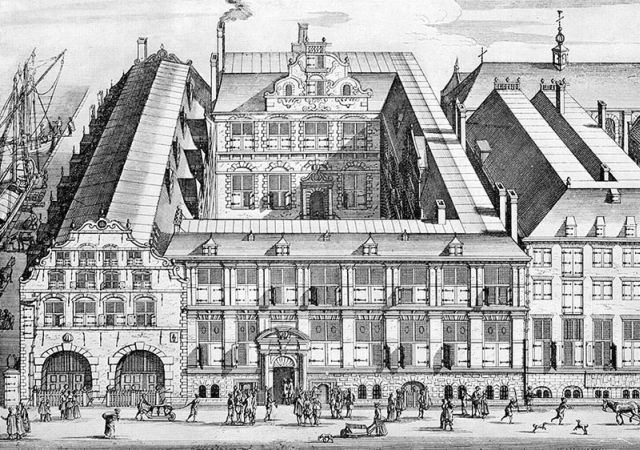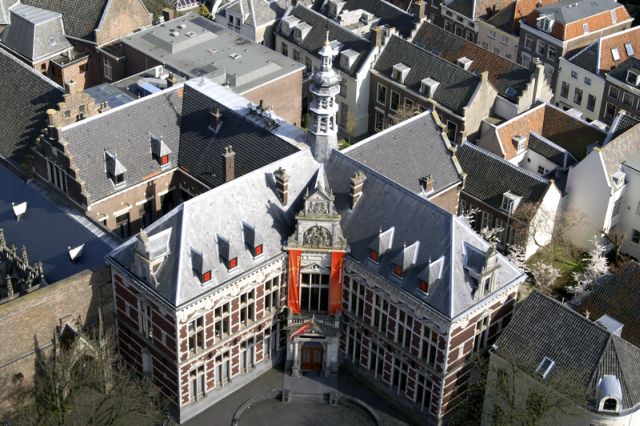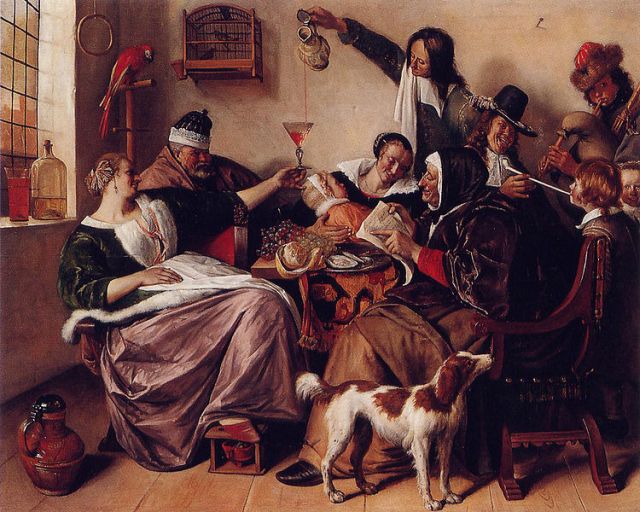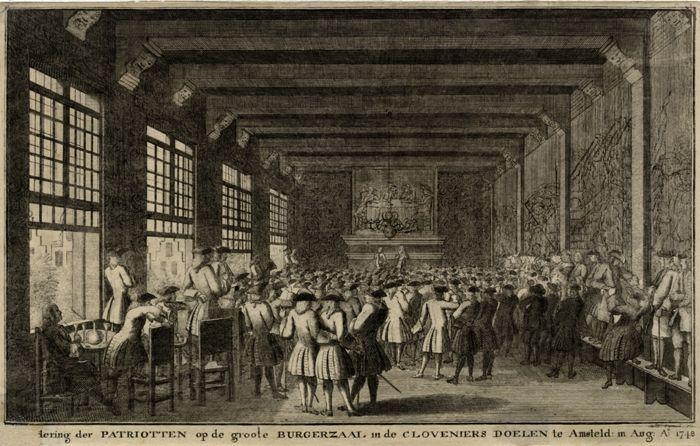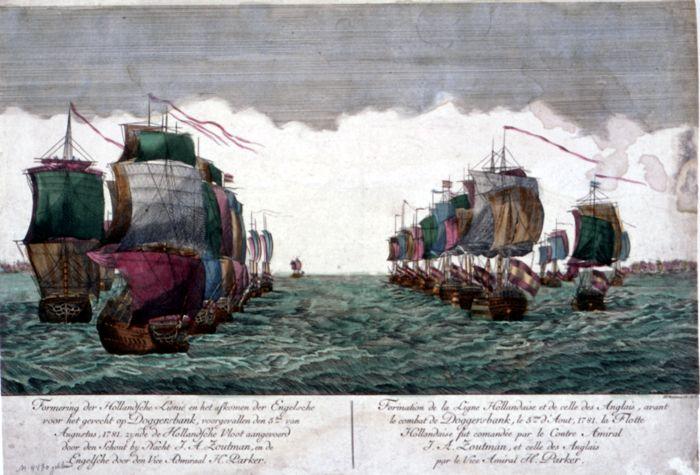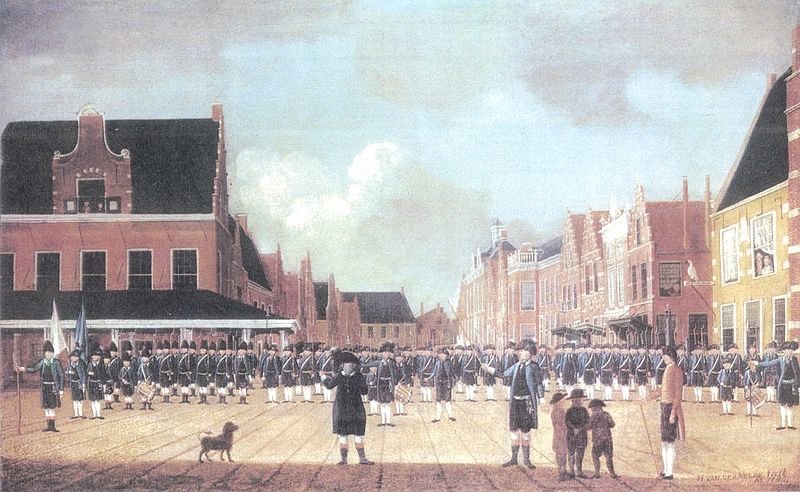HABSBURGS AND 7 UNITED PROVINCES
1. Under the rule of the Habsburgs
After Mary’s of Burgundy death the Duchy of Burgundy had been divided between France and the Habsburgs.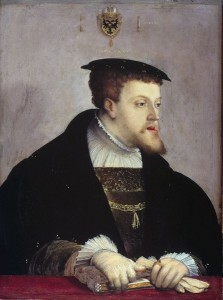 Under the treaty of Arras (1482) and Senlis (1493) Netherlands coincided with the Habsburgs, being ruled by the stadtholder. Thanks to Charles V (Mary’s grandson), emperor of Germany and king of Spain, the low-lying country became part of the enormous Habsburg Empire. In 1548 the Netherlands gained the official status of the state of the German Reich, and in 1549, under the so-called Pragmatic Sanction, became tied by personal union with the kingdom, which throne was inherited by the House of Habsburg. Habsburg dominion was somehow profitable for Netherlands as it strengthened process of merging Dutch provinces. On the other hand however it led to a permanent division of the Netherlands on the southern and northern part. Because of the profound differences between Spain (absolutist) and the Netherlands (parliamentary), it was a failed experiment, and in the second half of the 16th century, during the reign of Philip II, even very turbulent. On the painting: Charles V.
Under the treaty of Arras (1482) and Senlis (1493) Netherlands coincided with the Habsburgs, being ruled by the stadtholder. Thanks to Charles V (Mary’s grandson), emperor of Germany and king of Spain, the low-lying country became part of the enormous Habsburg Empire. In 1548 the Netherlands gained the official status of the state of the German Reich, and in 1549, under the so-called Pragmatic Sanction, became tied by personal union with the kingdom, which throne was inherited by the House of Habsburg. Habsburg dominion was somehow profitable for Netherlands as it strengthened process of merging Dutch provinces. On the other hand however it led to a permanent division of the Netherlands on the southern and northern part. Because of the profound differences between Spain (absolutist) and the Netherlands (parliamentary), it was a failed experiment, and in the second half of the 16th century, during the reign of Philip II, even very turbulent. On the painting: Charles V.
The main reasons for this were as follows:
- attempt to introduce Spanish absolutism in the country of the strong parliamentary tradition
- combating Protestantism, which was adopted in the Netherlands very well, although took many forms, from the extreme radical Anabaptism to Calvinism, burgeoning ideology of the bourgeoisie, who gladly accepted the praise of enrichment
- increasing fiscal pressure and treating the Netherlands as a source of financing constantly rising debts of Philip II
These three reasons led to growing hostility to the Spaniards, which were initi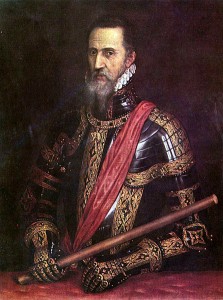 ally tolerated for Dutch merchant’s interests. In 1562 the feudal opposition arose, headed by William I, the Count of Nassau and Prince of Orange. In this situation Philip II tried to pacify the country by sending there in 1567 the Duke of Alba with 30 000 soldiers. Terror introduced by Alba resulted in the outbreak of the Eighty Years’ War (1568 – 1648) and the mass demonstrations of so-called Beggars (poor, peasants, fishermen), of both anti-feudal and anti-Spanish character. Also strong religious conflicts appeared at this time, as a consequence of religious inquisition, founded by the Spaniards as early as 1522. On the picture: Ferdinand Álvarez de Toledo, prince Alba.
ally tolerated for Dutch merchant’s interests. In 1562 the feudal opposition arose, headed by William I, the Count of Nassau and Prince of Orange. In this situation Philip II tried to pacify the country by sending there in 1567 the Duke of Alba with 30 000 soldiers. Terror introduced by Alba resulted in the outbreak of the Eighty Years’ War (1568 – 1648) and the mass demonstrations of so-called Beggars (poor, peasants, fishermen), of both anti-feudal and anti-Spanish character. Also strong religious conflicts appeared at this time, as a consequence of religious inquisition, founded by the Spaniards as early as 1522. On the picture: Ferdinand Álvarez de Toledo, prince Alba.
“Spanish furye” – a massacre in Antwerp, on November 4, 1576, when Spanish soldiers killed 8 000 inhabitants of the city
These events, especially the fear of the radicalism of the masses, highly deepened differences betwee n the two parts of the Netherlands, and then led to the disintegration of the country. Wishing to preserve feudalism, Catholic South voted on January 6, 1579 for Spain, which guaranteed the old order. Protestant North, wishing to defend parliamentarism, responded in creating on January 23, 1579 the union in Utrecht, which was joined by the seven provinces: Holland, Zeeland, Friesland, Utrecht, Gelderland, Overijsel, Groningen, as well as parts of the Flemish Flanders (Ghent, Bruges, Ypres, Antwerp). This Union laid foundations for the Republic of the Seven United Provinces which had never been proclaimed formally. It is regarded as its beginning the act of the deposition of Philip II on July 26, 1581. On the picture: signes on the act of establishment of the Union of Utrecht.
n the two parts of the Netherlands, and then led to the disintegration of the country. Wishing to preserve feudalism, Catholic South voted on January 6, 1579 for Spain, which guaranteed the old order. Protestant North, wishing to defend parliamentarism, responded in creating on January 23, 1579 the union in Utrecht, which was joined by the seven provinces: Holland, Zeeland, Friesland, Utrecht, Gelderland, Overijsel, Groningen, as well as parts of the Flemish Flanders (Ghent, Bruges, Ypres, Antwerp). This Union laid foundations for the Republic of the Seven United Provinces which had never been proclaimed formally. It is regarded as its beginning the act of the deposition of Philip II on July 26, 1581. On the picture: signes on the act of establishment of the Union of Utrecht.
However, this did not end the Dutch-Spanish War yet, which dragged on for more than 60 years.
The explosion of the Spanish flagship during the battle of Gibraltar, April 25, 1607
In the truce of April 9, 1609 Spain recognized the independence of the Republic of the Seven United Provinces, but the ultimate end of the Dutch-Spanish struggle was brought by the Treaty of Westphalia of January 30, 1648. Its conclusions approved the border between the Northern and Southern Netherlands and the sovereignty of the Republic. (The border between north and south was not finished, but that was never a problem.)
1.1 Netherlands in the 16th century
Despite wars and social conflicts the 16th century brought great economic development of the Northern Netherlands. Meanwhile South firmly declined, and many of its inhabitants migrated to the north and their capital contributed to the economic development of this part of the country. The best sign of progress was a high degree of urbanization, unprecedented in other countries. The economic leader was Holland, where as many as 52% of the population lived already in cities. In the second half of the 16th century very strong development experienced also Leiden, Haarlem, Rotterdam, Delft, and especially Amsterdam as the center of trade in the Baltic Sea. It was connected with development of industry and trade, as at this century modern, capitalist form of production (manufactory) replaced small family workshop production. Trade became increasingly based on capitalist joint-stock companies.
Het spinnen, het scheren van de ketting en het weven, Isaac Claesz van Swanenburg
Highly developed was already international trade, particularly flourished exchange in the Baltic Sea states. In the 60s of that century 66% of their goods were exported to Western Europe on Dutch ships. And ships of the Republic of the Seven United Provinces were unbeatable in terms of size, design and maneuverability.
Fluits – typical Dutch merchant ships of the Republic of the United Provinces
Dutch Naval History and 16th century maps
It became apparent that the power of the Northern Netherlands was well connected with the sea. At the end of the 16th century Dutch merchants started to grow interest in the East Indies, what initiated expeditions in search of convenient shipping routes. This led to geographical discoveries, such as the discovery of Spitsbergen by William Barents. Prosperity also concerned the village, where feudal relations, based on personal work, were gradually replacing by rents. Since half of the 16th century the use of the windmill highly improved efficiency of land drainage. Dutch peasant was relatively wealthy, and in Friesland and certain districts of Groningen he was even represented in States-Provincial!
The corn harvest, Peter Bruegel Elder
This does not mean, however, that in the Netherlands was no misery and poverty, which contributed to the collapse of traditional crafts. This led to revolution and mass occurrences of The Beggars in the second half of the 16th century.
A very important factor in shaping the Dutch society was the Reformation, which in the Northern Netherlands encountered a very fertile ground. Bourgeoisie particularly liked Calvinism as sanctioning enrichment and allowing earning a commission on the collection, as well as promoting democracy. The poor masses accepted radical theories of Anabaptism, which was directed against the social order.
Destruction of statues in Catholic churches in the picture Dirck van Delen, 1630
It is no wonder that the Anabaptists were not only opposed by fanatically Catholic Spaniards, but also by Protestants. Extremely severe persecution in the Netherlands forced many of them to flee to other countries in Europe, and some refugees (called Mennonites) settled down in Poland, in Żuławy. Read also: Netherlands in Zulawy.
Despite those turbulents there was a huge rise of the science and culture. In th e northern part of the country there were many schools of university-level, and in 1574 the University of Leiden was founded (the first in the country), highly valued by European Protestants, also the Polish ones. The first half of that century was a time of activity of great philosopher Erasmus of Rotterdam (read also: The lost Erasmus Library). Awakening of the national consciousness caused development of national languages – Dutch and Flemish, and the number of printing houses publishing national literature highly increased. The victory of the Protestant middle class also had an impact on the arts, what was reflected in paintings, more often veer from religious themes toward private scenes. Perfect examples of this kind of art are excellent Peter Breughel Elder paintings. On the painting: Erasmus of Rotterdam, Hans Holbein.
e northern part of the country there were many schools of university-level, and in 1574 the University of Leiden was founded (the first in the country), highly valued by European Protestants, also the Polish ones. The first half of that century was a time of activity of great philosopher Erasmus of Rotterdam (read also: The lost Erasmus Library). Awakening of the national consciousness caused development of national languages – Dutch and Flemish, and the number of printing houses publishing national literature highly increased. The victory of the Protestant middle class also had an impact on the arts, what was reflected in paintings, more often veer from religious themes toward private scenes. Perfect examples of this kind of art are excellent Peter Breughel Elder paintings. On the painting: Erasmus of Rotterdam, Hans Holbein.
1.2 Wilhelm I of Orange
The most prominent political figure in the 16th century was William of Orange, Count of Nassau and Prince of Orange (born 24 April 1533 – died 1510 July 1584), who is the hero of the Dutch national anthem “ Wilhelmus”. By his contemporaries he was called William the Silent. He began his political career in the service of the Habsburgs, was even favorite of King Charles V, who made him commander of one of his army, as well as a member of the Council of State – the highest advisory body in the Netherlands. In 1559 he became a stadtholder of Holland, Zealand and Utrecht. A very ambitious prince, however, was not satisfied by that, especially since the power was concentrated in hands of the Spaniards. He also disliked growing religious persecution (he was a devout believer, raised Protestant, then Catholic). These views and beliefs led him in the ’60s to advocate on the side of the opposition of the Dutch aristocracy, demanding, among other things, decentralization of power and softening anti-Protestant policies. He initially didn’t want to act openly against Philip II and even left the Netherlands for some time, only quietly supporting anti-Spanish revolt (the Sea Beggars). His plan was to incarnate politically the Netherlands in the sphere of the German Reich, while maintaining the freedom and privileges of the old order and the strengthening of Protestantism. When the Dutch-Spanish conflict escalated into open warfare, William became involved in it personally and took part in the military action, becoming the leader of the armed opposition and having the number of military successes.
Wilhelmus”. By his contemporaries he was called William the Silent. He began his political career in the service of the Habsburgs, was even favorite of King Charles V, who made him commander of one of his army, as well as a member of the Council of State – the highest advisory body in the Netherlands. In 1559 he became a stadtholder of Holland, Zealand and Utrecht. A very ambitious prince, however, was not satisfied by that, especially since the power was concentrated in hands of the Spaniards. He also disliked growing religious persecution (he was a devout believer, raised Protestant, then Catholic). These views and beliefs led him in the ’60s to advocate on the side of the opposition of the Dutch aristocracy, demanding, among other things, decentralization of power and softening anti-Protestant policies. He initially didn’t want to act openly against Philip II and even left the Netherlands for some time, only quietly supporting anti-Spanish revolt (the Sea Beggars). His plan was to incarnate politically the Netherlands in the sphere of the German Reich, while maintaining the freedom and privileges of the old order and the strengthening of Protestantism. When the Dutch-Spanish conflict escalated into open warfare, William became involved in it personally and took part in the military action, becoming the leader of the armed opposition and having the number of military successes.
To honor the heroism of the citizens of Leiden, who in 1574 defended the town against the Spaniards, he founded there the first university in the Netherlands. After the establishment of the Union of Utrecht in 1579 he was initially skeptical towards it (he dreamed of uniting all the provinces), but eventually supported it. After dethroning Philip II in 1581 he was considered as the Earl of Holland and Zeeland, which did not meet his ambitions as he quietly dreamt of being a ruler over the entire Northern Netherlands. Unhappily his political career was ended rapidly but the murdering of the only 51-year-old prince. He was murdered on July 10, 1583 by a fanatical Catholic from Burgundy, Balthasar Gérard, for he was (in his eyes) a traitor to Philip II and the Catholic faith.
Assasinating of William Orange by Balthasar Gérard
He married four times, William left fourteen children and also one illegitimate. (Currently reigning Queen Beatrix comes from the side line of Orange-Nassau dynasty.) In the Netherlands William I of Orange is called the Father of the Homeland. From him comes the Netherlands flag of three colors (although he used an orange instead of red), the motto of the Netherlands “Je maintiendrai” and orange as the informal color of the nation. William and his battle with the Spaniards are presented in the Dutch anthem Het Wilhelmus.
2. Republic of Seven United Provinces
Republic of Seven United Provinces existed in years 1579 -1795, but had never been officially proclaimed. Practically it was a confederation of seven provinces: Holland, Zeeland, Friesland, Utrecht, Geld erland, Groningen and Overijsel and their representatives were obliged to represent particular interests of their region. The basic power was exercised by State-Provincial and the composition, structure and membership were different in different provinces. The State-Provincial consisted of aristocracy, nobility, bourgeoisie and in some cases (Friesland) also peasants. The system was further complicated by the fact that the States-Provincial included representatives of local (rural and urban) councils who were dependent from those councils, and they had to have their permission to make specific decisions. Common representation of the States-Provincial created State-General which considered issues concerning the Republic as a whole (foreign policy, army and navy), but had no right to enact binding legislation – this competence belonged to the State-Provincial. It significantly weakened the efficiency of power because deputies of the State-General (there was no limit of provincial delegates, but each province had only one vote) had to get approval of their States-Provincial and their deputies had to get acceptance of local councils, what considerably delayed proceedings. On the picture above: a map of the Seven United Provinces from 1658.
erland, Groningen and Overijsel and their representatives were obliged to represent particular interests of their region. The basic power was exercised by State-Provincial and the composition, structure and membership were different in different provinces. The State-Provincial consisted of aristocracy, nobility, bourgeoisie and in some cases (Friesland) also peasants. The system was further complicated by the fact that the States-Provincial included representatives of local (rural and urban) councils who were dependent from those councils, and they had to have their permission to make specific decisions. Common representation of the States-Provincial created State-General which considered issues concerning the Republic as a whole (foreign policy, army and navy), but had no right to enact binding legislation – this competence belonged to the State-Provincial. It significantly weakened the efficiency of power because deputies of the State-General (there was no limit of provincial delegates, but each province had only one vote) had to get approval of their States-Provincial and their deputies had to get acceptance of local councils, what considerably delayed proceedings. On the picture above: a map of the Seven United Provinces from 1658.
Binenhof in Haga, place of the meeting of the States General from the 15th century
The other weaknesses of the Republic were: lack of central administration, judiciary, water policy and common fiscal policy; decentralization of the army and fleet (each province had its own), as well as provincial particularism, whose interests were often contradictory. The strongest and most politically dominant province, especially from the mid-17th century, was Holland, which brought to the budget of the Republic 58% of the funding. Its dominance was met with a high concern of other provinces.
States-Provincial were not the only center of power in the Republic, as a stadtholder office was maintained (a remnant of the Spanish rule). Stadtholder was a function existing only in the provinces and was initially appointed by the State-Provincial, later hereditary. He had an impact on the composition of the State-General; he was also a commanderof the army and navy. Thanks to focusing few governors in one hand stadtholder coud get a very strong political position. In emergency the strongest of them, and it was always the Prince of Orange, became the chief commander of the army and navy. It is necessary to mention that in the beginning of the Republic nobody imagined rules of the parliamentary government – it was ment to be only a transitional form. So supporters of monarchical rule focused around the family of Orange. Conflict between those two centers of power, parliamentary (the regents) and the prince, was a permanent feature of the political landscape of the Republic of the Seven United Provinces. (To make things even worse, in Holland was the office of the Grand Pensionary, who also had strong political position.) It happend, for example, on the occasion of the Treaty of Westphalia in 1648, that the Prince of Orange wanted to continue the war with Spain, while the mercantile orientated State-General sought to peace. There were also periods without stadtholders, like years 1650 – 1672 (the result of anti-Orange policies of John de Witt, the Grand Pensionary of Holland).
More on the Orange dynasty in The House of Orange.
2.1 Wars with England and France
Most of the first century of the Republic of the Seven United Provinces was marked by rivalry with England in the field of navigation, maritime trade and fishing. Conflicts, disputes and animosities grew by years, which led to the outbreak of three wars.
- 1st war (1652 – 1654) – the reason was the British claim of the payment of fees by Dutch fishermen, forcing them to salute the flag of England, the attempt to impose a monopoly on the import to England (i.e. Navigation Act) and the debate on the neutrality of the sea. In the treaty of peace Republic accepted some demands.
Battle of Scheveningen August 10, 1653, Jan Abraham Beerstraaten
- 2nd war (1665 – 1667) – one of the reasons was occupation the Dutch colonies in America and West Africa by Britain. During the war the Dutch were able to sail on the River Thames up to London. As a result of the peace in Breda Englishmen softened provisions of the “Act of Navigation.”
- 3rd war (1672 – 1674) – this time Britain was supported on land by France. In a critical situation (1672) the Republic renewed stadtholder office, giving it to William III. For his contribution to the liberation of the country princes of the Orange House were given the right to inherit this function. (In this war merchants of Amsterdam, caring much of their business, delivered ammunition also to French army.)
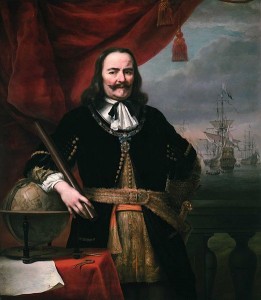 One of the commanders of the Dutch fleet was Admiral Michiel de Ruyter. In 1673, right before one of the battles against the British, he preached in very unusual way. Knowing that weather did not favour military relief and that English will also be praying, he asked God not to intervene in the battle. God heard his request, because both fleets annihilate each other and nobody won this fight. On the painting: Michiel de Ruyter.
One of the commanders of the Dutch fleet was Admiral Michiel de Ruyter. In 1673, right before one of the battles against the British, he preached in very unusual way. Knowing that weather did not favour military relief and that English will also be praying, he asked God not to intervene in the battle. God heard his request, because both fleets annihilate each other and nobody won this fight. On the painting: Michiel de Ruyter.
From the 70s there was a growing threat from France, which under the rule of Louis XIV began to pursue an imperialistic policy. Not without significance was anti-Protestant attitude of the French king. It was him who inspired the outbreak of the 3rd war with England. French troops entered in 1672 to the North of the Netherlands (Dutch defended their country by flooding it with water), and began to perch in the Southern Netherlands. This led to the establishment by the Republic allied relations with England, and even to the marriage of William III and Mary Stuart (1677). In the future he became even king of England (after the overthrow of the Catholic James II). Fights with France held on until 1697, when the peace was signed in Rijswijk, by which France recognized William III of Orange as the King of England and allowed the Republic to maintain its garrisons in the “Spanish” (Southern) Netherlands. On the painting: William III.
England. French troops entered in 1672 to the North of the Netherlands (Dutch defended their country by flooding it with water), and began to perch in the Southern Netherlands. This led to the establishment by the Republic allied relations with England, and even to the marriage of William III and Mary Stuart (1677). In the future he became even king of England (after the overthrow of the Catholic James II). Fights with France held on until 1697, when the peace was signed in Rijswijk, by which France recognized William III of Orange as the King of England and allowed the Republic to maintain its garrisons in the “Spanish” (Southern) Netherlands. On the painting: William III.
2.2 The Dutch Golden Age
Despite numerous wars the 17th century was one of the best periods in history of the Netherlands and is called the Dutch Golden Age. The country was quite unique to the then European standards, and not only because of the numerous dykes, canals and windmills. The peculiarity was that cities were very clean, houses comfortable, cattle neat and people wealthy. Unusual was that this small, numbering only 2 million inhabitants country without any minerals and natural resources. Income came only from fishing and maritime trade, followed by their agriculture, industry and banking services. When it comes to interna-tional trade, a large part of it was Polish grain trade, which led to lively contacts with Gdansk and Szczecin.
A mother by the cradle, Pieter de Hooch
Dutch trading activity was not limited to Europe. At the beginning of the 17th century Dutch merchants started their colonial activity, creating two join-stock companies: the United Company of the East (Oost-Indische Verenigde Compagnie – VOC) and Company of Western India (West-Indische Compagnie – WIC). The purpose of the VOC, operating in the territory of today’s Indonesia, was sourcing and trading of the highly valued spices, which gave shareholders an extraordinary profit.
The VOC residence, 17th century
The WIC, in turn, had to fight militarily with Spain and Portugal, which were dominant on the colonial market. Dutch colonies are discussed separately in the History of the colonies section.
 The Dutch Golden Age also witnessed a huge development of the industry, in huge part textile, largely based on imported raw and prefabricated materials. Larger companies had already an early capitalistic character. In develop-ment were gardening (including growing tulip) and arboriculture, and modern system of draining by windmills let gaining more ground. In 1609 the Bank of Amsterdam was established, and in 1611 the stock exchange had been officially opened. Both institutions had a large impact on monetary policy in Europe. On the painting: the old Council Hall in Amsterdam, the first seat of the Bank of Amsterdam, Pieter Jansz. Saenredam.
The Dutch Golden Age also witnessed a huge development of the industry, in huge part textile, largely based on imported raw and prefabricated materials. Larger companies had already an early capitalistic character. In develop-ment were gardening (including growing tulip) and arboriculture, and modern system of draining by windmills let gaining more ground. In 1609 the Bank of Amsterdam was established, and in 1611 the stock exchange had been officially opened. Both institutions had a large impact on monetary policy in Europe. On the painting: the old Council Hall in Amsterdam, the first seat of the Bank of Amsterdam, Pieter Jansz. Saenredam.
So the middle class got more and more rich, but a draconian (and very complicated) tax system and modern production methods ruined many small manufacturers. It was somehow compensated by a well-developed charity. Wealth conducived to education – many Dutchmen knew foreign countries and languages. In terms of education, the Republic was significantly ahead of all other European countries. The level of illiteracy was very low as a result of the existence of numerous schools run by the Calvinist churches. And what is interesting, children could get education regardless of their social position. In the first half of this century in the Northern Netherlands operated already 6 universities, 4 of which still exist today. At the end of the 17th century the Republic printed more books thanthe rest of Europe (Dutch publications were even often banned in other countries).
University in Utrecht
At that time Northern Netherlands were famous for the high level of their science, inventions (particularly meritorious were Christian Huygens and Antoni van Leeuwen-hoek), cartography, medicine (the famous anatomy lessons) and philosophy (Spinoza, Grotius). The 17th century was also successful for the culture. Not only the rich but also the poor people could buy paintings, and the list of prominent artists is extremely long (of course, it starts with Rembrandt van Rhijn). Favorite paintings were the subjects of daily life and views of the area.
Jak starzy śpiewają, tak młodzi zagrają, Jan Steen
2.3. 18th century – The fall
The 18th century the Republic of the Seven United Provinces began without a stadtholder, because in 1702 William III died childlessly – he expired this way the line of direct descendants of William I. The century was marked by a struggle with France (growing more and more in power) and the collapse of the international significance of the Republic. Another problem was the never ending conflict of the pro- and anti-Orange parties. The big threat from France originated from Spanish succession of Louis XIV’s grandson Philip of Anjou, as King Charles II, who died childless, appointed him his successor (it could give France the power in a huge Franco-Spanish empire). For this reason the Republic, desiring to have Spain inherited by the Austrian Habsburgs, became involved in the War of the Spanish Succession (1701-1713), conducted in alliance with England and Austria. The profit was not great – although the Dutch retained control of the Southern Netherlands, but increasingly ceased to be reckoned on the international stage (and even did not manifest higher ambitions in this field). The land became dominated by France on the land and by England on the water. In the years 1744-1748 in the war of the Austrian Succession (its goal was to make the Elector of Bavaria the German emperor to weaken the House of Habsburg), the French invaded territory of the Republic.
Meeting of patriots in a big hall Cloveniers Doelen te Amsterdam, August 1748
An important event in the first half of this century was the election of William IV (of the Frisian side line of the House of Orange) to the stadtholder of all seven provinces – the function was even ment to be hereditary. In 1776 American colonists started an uprising against England, what forced the Republic to take one of the sides. Wishing to weaken the dominance of England on the seas, the State-General decided to support the Americans and provided them with weapons.
Interesting note:
It happened that on November 16, 1776 an American ship the USS Andrew Doria, with the new American flag in the top, arrived to the Dutch island St. Eustatius on Lesser Antilles (Caribbean Sea), at this time the colony of the Dutch company WIC, and the Dutch Fort Orange saluted on the order of Jan de Graaf. In response the ship gave a salut of 11 shots. It was the first time that the flag of the United States was saluteted by a foreign country. The Americans immediately interpreted it as the first official recognition of their independence. One and a half century later the American President Franklin Delano Roosevelt visited St Eustatius (1939) and gave the island a plaque commemorating it. It says among other things: “Here the sovereignty of the United States of America was first formally acknowledged to a national vessel by a foreign power.”
This led to the outbreak of the 4th war with England (1780 – 1784), but the already overstressed Republic, with its aging fleet, was this time, not able to achieve success.
Battle on Dogger Bank – Dutch ships
This defeat led to a further decline of her prestige and a growing weakness to France. Also high were economic damages – while prior to 1780 about 2000 Dutch ships sailed per year through the Øresund Strait, in 1781 the number shrunk up to… 11! The war consequences eventually led to the collapse of VOC and WIC. The internal situation was also uneasy. In the 70s and 80s the anti-Orange movement, represented by the so-called patriots, intensified its activity. It was a democratic movement based on the middle and small bourgeoisie, which called for reform of the state and limiting the stadtholder power. So called patriots deprived the stadtholder from a lot of his power, and even forbade singing the famous song “Wilhelmus” (honoring Wilhem I).
Patriots from Sneek, Hermanus van de Velde
There were some bloody clashes between patriots and the ount of Orange supporters. The Republic even stood on the brink of a grim civil war. It was prevented only by intervention of Prussia (1788), which restored stadtholders power. During this period many patriots emmigrated to France, where they adopted the new revolutionary ideas. Increasingly they also began to use the name of Batavs for the Dutch nation. The end to the Republic of the Seven United Provinces came in 1795 with the entry of the French army. Wilhelm V left for England.
Note:
At the same time (1795) Poland disappeared from the map of Europe for more than a century. The hope for independence was brought with the reign of Napoleon Bonaparte, whose political star began to rise soon. Bonaparte fought with Russia, Austria and Prussia, who made the partitions of Poland. For the Dutch the French Emperor was the invider. From these different experiances originates a different approach to Napoleon in both countries, although he did nothing to meet the hopes connected with him by the Poles.
There were many reasons for the fall of the Republic, so powerful in the previous century. The most important was a decrease in the share of the world trade by increasing competition of England and other countries (the proportion of the number of vessels in England and in the Republic in the 17th century was 1:5, in the 18th century – already 6:1). Another one was decreasing participation of the Republic in commercial intermediary due to the fact that competitors were also able to build modern ships for safe transportation of perishable goods. Shrinking markets abroad led to the collapse of the industry, fisheries declined. Also a negative effect had increasing tax burden, corruption and excessive favoring the highest social elites.

